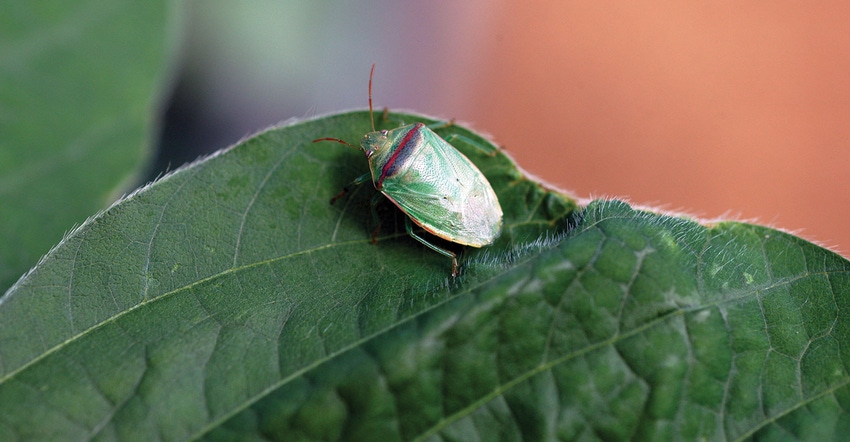April 7, 2020

A mild winter may subject Mid-South soybean farmers to increased red-banded stink bug pressure for the 2020 crop. Although scouting is not routine for soybeans, farmers might need to work with a consultant to stay ahead of the pests.
"We saw higher counts closer to our state in 2019, and our second mild winter in a row may bring earlier activity, higher populations, and control problems," says Scott Stewart, professor, entomology and IPM Extension specialist, West Tennessee Research and Education Center, Jackson, Tenn. "They're more likely to come on strong in August or September when southern green stink bug activity traditionally begins."
Comments from entomologists further south agree with Stewart's suspicion. "The winter we had in Mississippi does not seem to have been cold enough to substantially reduce their numbers," says Angus Catchot, cotton and soybean, Extension professor, Mississippi State University. "We fully expect dealing with this pest to a much larger degree this year than last."
Catchot is encouraging farmers to plant soybeans as early as possible. "This will minimize the pest's impact, to an extent," Catchot says. "We will begin ditch bank sampling soon and will report those numbers in a timely manner to give our producers insight to what they might expect as they progress through the crop year."
Sebe Brown, field crop Extension entomologist, LSU AgCenter agrees with Stewart and Catchot. "The warm temperatures we are experiencing currently are setting us up for higher populations of the pest," he says. "In the central part of our state, we've been finding live adults on alternate hosts, especially clover, since the first week of January."
Jeremy Ross, Extension agronomist, University of Arkansas System of Agriculture, thinks his state may in the same position as the other Mid-South states. "Red-banded stink bug populations could potentially have overwintered further north than the last two years. In addition to ditch banks, our entomologists will survey crimson clover cover-cropped fields for overwintering levels," Ross says.
"I have heard Orthene, some of which is manufactured overseas, may be in short supply because of anticipated increased red-banded stink bug populations. The disturbance in the world market from the Covid 19 situation could delay availability. I would suggest asking your retailer sooner than later."
Warm winters and warm early-season temperatures set up opportunities for other pests.
Late season threats
Pest management is more predictable late in the growing season when populations can increase. "I believe we'll see more late-season problems with the red-banded stink bug and the southern green stink bug, which are typically rare in our state," Stewart says. "We have other insect pests like the three-cornered alfalfa hopper, kudzu bug, and southwestern corn borer that tend to be more active after mild winters."
Stewart urges farmers to be aware of these pests and scout frequently as the season progresses. "Applying control measures early is always best," he says.
Certain pests are more tolerable of winters. "Plant bugs can handle colder temperatures. Their populations are affected more by what happens moving into the season," Stewart says. "A warm spring can help them get a fast start on wild host plants, where they could remain during the wet spring until later in the season. When they do move into cotton, it can be in big numbers."
Predicting how warm winters will influence pest populations is difficult. "I'll bet we are going to see more 'southern' insect pests this year. Be prepared," Stewart said.
About the Author(s)
You May Also Like






